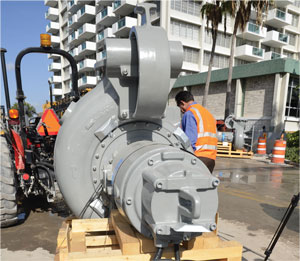It’s no secret that Miami-Dade County’s coastal cities will be ground zero for the potential negative impact of rising sea levels. A 2014 World Resources Institute study showed southeast Florida’s average annual rate of sea-level rise from 1993 to 2010 was almost twice that of the period from 1901 to 2010.
And a July report by the Risky Business Project, which aims to quantify the economic risks of climate change, estimated that by 2030 Florida coastal properties worth $69 billion could flood at high tide. Roughly half of the exposed real estate assets are in Miami-Dade County.
As the rising sea-level debate swells, officials in Miami-Dade County’s coastal cities are exploring and adopting measures to prevent massive flooding, such as raising building and road elevations and restoring eroded shorelines. Yet some stakeholders, such as architects and activists, claim business and government leaders are not working on a cohesive plan to ensure that greater Miami and its barrier islands will remain above water.
“There is a lot of lip service out there,” said Daniel Ciraldo, a member of Florida International University-City of Miami Beach Sea Level Rise Initiative. “We need to work with policymakers and prepare for things in advance rather than wait for disaster down the road.”
Officials in the coastal cities of Aventura, Key Biscayne, Miami Beach and Sunny Isles Beach insisted, however, that addressing the rising sea-level threat is a top priority. Bal Harbour, Bay Harbor Islands, Golden Beach and Surfside officials did not reply to requests for comment.
Since Aventura’s incorporation in 1995, more than $10 million has been spent to install larger drainage pipes, add pipes in areas without them and increase the stormwater collection system’s capacity, City Manager Eric Soroka said via email. Next year’s budget allocates $1.6 million for more drainage improvements and updates the city’s stormwater master plan. Aventura has mandated since 1997 that the lowest finished floor in new construction be 1 foot above the flood elevation set by the Federal Emergency Management Agency, although waivers can be granted for flood-proofing structures.
In Sunny Isles Beach, developers must build 7 to 10 feet above FEMA’s flood-elevation zone, according to City Manager Christopher Russo. “In recent years, we have spent approximately $10 million to improve stormwater management and address flood prevention in our city,” he said via email.
Mayor Mayra Lindsay said Key Biscayne also demands developers build at least 7 feet above FEMA’s flood-elevation zone. In addition to investing millions of dollars in stormwater management systems, Key Biscayne annually sets aside funding to “renourish” beaches with sand erosion. “We don’t wait until crisis mode,” she said.
Miami Beach is taking the drastic step of raising the height of roads, sidewalks and drainage systems to stave off flooding from the sea. “Two years ago, there was a significant outcry regarding sunny-day flooding caused by high tides,” said city engineer Bruce Mowry. “We literally had people paddling [in kayaks] in the streets.”
18th Street to 20th Street on Purdy Avenue in the Sunset Harbour neighborhood. The street and sidewalks on nearby Alton Road between Lincoln Road and Dade Boulevard were boosted 1.5 feet. New water pumps installed from Fifth to Eighth streets between Alton Road and West Avenue target chronic flooding by the entrance to South Beach. Over the next 50 years, the city intends to spend $300 million to add 60 to 80 water pumps all over, Mowry said.
The city commission will soon consider a staff recommendation to raise the finished floor elevation of new buildings four feet above FEMA’s flood-elevation zone, Mowry said. Currently Miami Beach does not require building above FEMA’s flood-elevation zone.
Reinaldo Borges, chairman of the sea-level-rise task force of the American Institute of Architects’ Miami chapter, said developers, government officials and environmentalists must collaborate to find the best solutions to the watery threat. Builders are pursuing opportunity in a booming real estate market without seriously considering sea levels, he claimed. No one in the development sector wants to take on what’s “a future issue for others to worry about,” he added, noting, however, that insurers say “this will have a significant impact on how buildings will be insured.”
But Truly Burton, Builders Association of South Florida executive vice president , insisted, “It is an issue of great concern to us.” Noting a lack of data for calculating the risk in 50 to 100 years, Burton cited the need for monitoring sea levels. “You don’t want to spend millions to elevate some roadway or a building and then later find out the flooding is actually going to occur farther up the coastline.”
